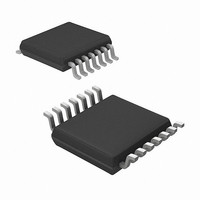MRF49XA-I/ST Microchip Technology, MRF49XA-I/ST Datasheet - Page 50

MRF49XA-I/ST
Manufacturer Part Number
MRF49XA-I/ST
Description
IC RF TXRX 433/868/915 16-TSSOP
Manufacturer
Microchip Technology
Datasheet
1.MRF49XA-IST.pdf
(102 pages)
Specifications of MRF49XA-I/ST
Package / Case
16-TSSOP
Frequency
433MHz, 868MHz, 915MHz
Data Rate - Maximum
256kbps
Modulation Or Protocol
FHSS, FSK
Applications
Home / Industrial Automation, Remote Access, Security Alarms
Power - Output
7dbm
Sensitivity
-110dBm
Voltage - Supply
2.2 V ~ 3.8 V
Current - Receiving
11mA
Current - Transmitting
15mA
Data Interface
PCB, Surface Mount
Antenna Connector
PCB, Surface Mount
Operating Temperature
-40°C ~ 85°C
Number Of Receivers
1
Number Of Transmitters
2
Wireless Frequency
433 MHz to 915 MHz
Output Power
+ 7 dBm
Operating Supply Voltage
2.5 V, 3.3 V
Maximum Operating Temperature
+ 85 C
Mounting Style
SMD/SMT
Minimum Operating Temperature
- 40 C
Modulation
FHSS, FSK
Lead Free Status / RoHS Status
Lead free / RoHS Compliant
Memory Size
-
Lead Free Status / Rohs Status
Lead free / RoHS Compliant
Other names
579-MRF49XA-1/ST
Available stocks
Company
Part Number
Manufacturer
Quantity
Price
Company:
Part Number:
MRF49XA-I/ST
Manufacturer:
IR
Quantity:
450
Part Number:
MRF49XA-I/ST
Manufacturer:
MICROCHIP/微芯
Quantity:
20 000
3.6
The crystal oscillator of MRF49XA requires a 10 MHz
Parallel mode crystal. The circuit contains an inte-
grated load capacitor in order to minimize the external
component count. The internal load capacitance value
is programmable from 8.5 pF to 16 pF in 0.5 pF steps.
With appropriate PCB layout, the total load capacitance
value can be 10 pF to 20 pF, so a variety of crystal
types can be used.
When the total load capacitance is not more than 20 pF,
and a worst case 7 pF Shunt Capacitance (C
expected for the crystal, the oscillator is able to start-up
with any crystal having less than 100Ω Equivalent
Series Loss Resistance (ESR). However, the low C
and ESR values ensure the faster oscillator start-up.
FIGURE 3-5:
DS70590B-page 48
MRF49XA
Crystal Selection Guidelines
Bit Rate: 2.4 kbps
Bit Rate: 9.6 kbps
Bit Rate: 38.4 kbps
Bit Rate: 115.2 kbps
433 MHz
868 MHz
915 MHz
433 MHz
868 MHz
915 MHz
433 MHz
868 MHz
915 MHz
433 MHz
868 MHz
915 MHz
Do Not Use
Do Not Use
Do Not Use
MAXIMUM CRYSTAL TOLERANCES INCLUDING TEMPERATURE AND AGING (ppm)
Do Not Use
Do Not Use
Do Not Use
105
30
20
10
10
30
15
30
8
8
Do Not Use
Do Not Use
45
30
20
15
45
30
15
15
45
5
3
3
120
3
S
) value is
Preliminary
Deviation [± kHz]
Deviation [± kHz]
Deviation [± kHz]
Deviation [± kHz]
60
50
25
25
60
50
25
25
60
20
10
10
S
135
20
10
10
The Crystal Frequency (f
the PLL, which generates the Local Oscillator Fre-
quency (f
The accuracy requirements for production tolerance,
temperature drift and aging can thus be determined from
the maximum allowable local oscillator frequency error.
Whenever a low-frequency error is essential for the
application, it is possible to “pull” the crystal to the accu-
rate frequency by changing the load capacitor value.
The widest pulling range can be achieved if the nominal
required load capacitance of the crystal is in the “mid-
range”; for example, 16 pF. The “pull-ability” of the
crystal is defined by its Motional Capacitance (C
shunt capacitance.
75
70
30
30
75
70
30
30
75
30
20
15
150
30
20
15
LO
). Therefore, f
90
90
40
40
90
80
40
40
90
50
25
25
165
50
25
25
© 2009 Microchip Technology Inc.
LO
ref
105
100
105
100
105
50
50
50
50
75
30
30
180
) is used as the reference of
70
35
30
is directly proportional to f
120
100
120
100
120
195
60
50
60
50
75
40
40
80
45
40
m
) and
ref
.












